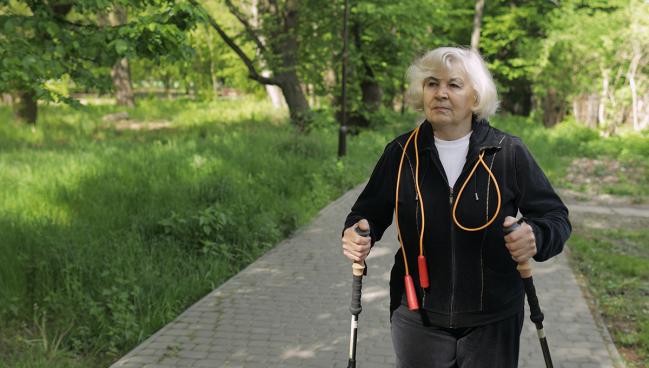For Coronary Heart Disease, Upping Exercise Over Time Linked to Survival Gains
Big benefits were seen in those who remained as active as before the diagnosis and in those who ramped up their exercise.

Increasing the amount of physical activity after a diagnosis of coronary heart disease (CHD), or even maintaining the same exercise habits, is associated with a lower risk of all-cause and cardiovascular mortality, a new review confirms.
The findings emphasize not only the importance of staying active after a CHD diagnosis but show that a prior sedentary lifestyle can be overcome with changes in lifestyle, say researchers.
“The survival benefits of lifestyle physical activity for CHD patients are likely not solely dependent on past levels of activity but are combined with present levels of physical activity as well,” write Nathalia Gonzalez-Jaramillo, MD (Institute of Social and Preventive Medicine, Bern, Switzerland), and colleagues online April 25, 2022, in the Journal of the American College of Cardiology.
Given these data, the evaluation of habitual physical activity and individual trajectories should become part of routine care, they add. “Incorporating CHD patients’ physical-activity trajectories evaluation into the clinical routine could guide prognosis, counseling, and shared decision-making, and could trigger a deeper analysis of comorbidities and functional status in case of decreasing activity.”
As Much as a 50% Reduction
Exercise has long been known to protect against CVD and mortality, and both the US and European guidelines emphasize physical activity for people with chronic health conditions, including CHD. Recommendations for physical activity, though, have been mostly based on longitudinal studies using a single assessment or an average of physical activity levels over an extended period.
In the past, studies addressing the interaction between physical-activity trajectories and mortality in people with coronary heart disease over time have been mixed. Some studies suggest that increasing the amount of exercise lowers mortality risk, while others found no impact.
To characterize the effect of changing exercise patterns over time, the researchers identified nine longitudinal cohorts reporting the association of physical-activity trajectories with mortality in 33,576 patients (mean age 62.5 years) with CHD. Mean follow-up in the studies was 15.7 years. Physical activity, which was assessed with validated questionnaires, was categorized into four different time-based trajectories: always inactive, consistently active over time, increased activity over time, and decreased activity over time.
Compared with those who stayed inactive, CHD patients who maintained their activity levels during follow-up had a significant 50% lower risk of death. Those who increased the amount of exercise they were doing had a significant 45% lower risk of all-cause mortality. Those who decreased the amount of physical activity over time still had a lower risk of death than those who were never active, but this benefit was attenuated compared with those who maintained or increased their activity (HR 0.80; 95% CI 0.64-0.99).
When compared with the inactive group, those who remained active or increased their activity levels had a significant 52% and 37% lower risk of cardiovascular mortality, respectively. There was no difference in cardiovascular death between those who were inactive and those who dropped off their activity over time.
Start With Exercise First
Claudio Gil Araújo, MD, PhD (CLINIMEX, Rio de Janeiro, Brazil), who wasn’t involved in the study, emphasized that physicians involved in secondary or tertiary prevention need to get patients moving as part of their rehabilitation.
“Most people start with statins, aspirin, beta-blockers, and so on, and maybe at the end they’ll tell the patient to try to eat well and get some exercise,” he told TCTMD. “I would say you need to change the order. Turn that around. Start with lifestyle and then add medication if you need it. This paper reinforces that.”
Modifying other cardiovascular risk factors, such as hypertension or dyslipidemia, reduces the risk of mortality and repeat CVD events, and such treatment has its role, but the magnitude of benefit is significantly larger with physical activity, Araújo stressed.
Most people start with statins, aspirin, beta-blockers, and so on, and maybe at the end they’ll tell the patient to try to eat well and get some exercise. I would say you need to change the order. Claudio Gil Araújo
He agreed with the researchers’ conclusions that patients should be encouraged to maintain their activity levels after a CAD diagnosis. This study also shows that patients with established CAD can overcome periods of inactivity, as reflected in the benefit observed among patients who increased their physical activity over time (having been inactive prior to their CAD diagnosis). For these patients, the survival benefit is on par with those who were active all along, said Araújo.
“It’s a very interesting study,” he said. “It’s one step ahead of previous studies. . . . They took a nice approach that looked at people who change or didn’t change their physical activity.”
‘Use It or Lose It’
For physicians looking to guide patients on lifestyle, Araújo highlighted the principles of frequency, intensity, time, and type (FITT). Over the last several years, there have been data showing the value of increasing exercise intensity, said Araújo. “You have to tell your body that you need to achieve a very high level [of intensity] every once in a while,” he commented. “You need to reach your maximum.”
That said, Araújo stressed the importance of individualizing exercise prescriptions, just as doctors titrate medications for their patients. The American Heart Association considers cardiorespiratory fitness a vital sign, so individuals will require different amounts of activity at different intensities to achieve optimal aerobic capacity. While cardiac rehabilitation programs after a CHD diagnosis are a good start, they should be considered just the beginning of a patient’s lifelong exercise habits, said Araújo.
In an editorial accompanying the study, Christie Ballantyne, MD, and John Davis, BA (Baylor College of Medicine, Houston, TX), point out that there will never be a randomized clinical trial assigning CHD patients to maintaining, increasing, decreasing, or stopping physical activity, so this meta-analysis is the best long-term evidence there’s going to be.
“The message therefore is clear and straightforward: physical activity is extremely important for long-term outcomes in the patient with coronary heart disease,” they write. “Increasing physical activity after an event is highly beneficial, and conversely, if an individual becomes inactive, much of the benefit is lost, which is supportive of the phrase ‘use it or lose it.’”
Michael O’Riordan is the Managing Editor for TCTMD. He completed his undergraduate degrees at Queen’s University in Kingston, ON, and…
Read Full BioSources
Gonzalez-Jaramillo N, Wilheim M, Arango-Rivas AM, et al. Systematic review of physical activity trajectories and mortality in patients with coronary artery disease. J Am Coll Cardiol. 2022;79:1690-1700.
Ballantyne CM, Davis JW. Exercise and mortality in heart disease cohorts: meta-analysis to augment available evidence. J Am Coll Cardiol. 2022;79:1701-1703.
Disclosures
- None of the authors or editorialists report any relevant conflicts of interest.





Comments